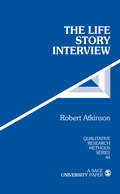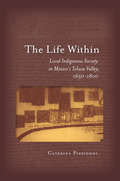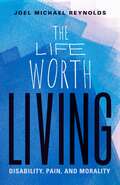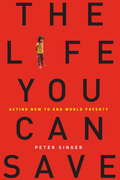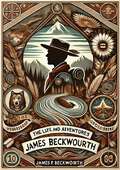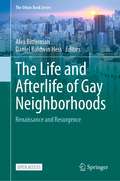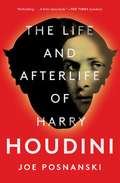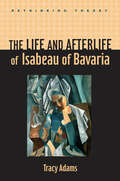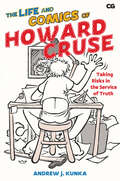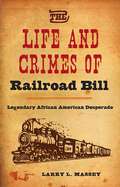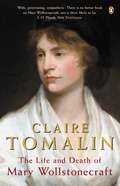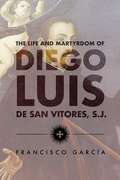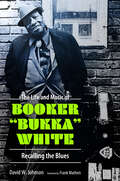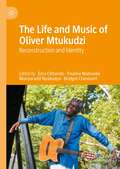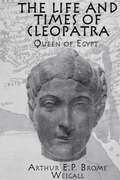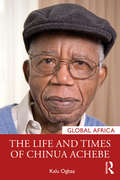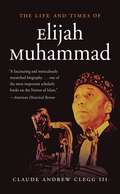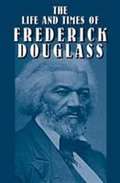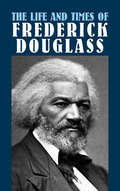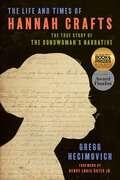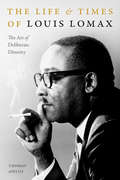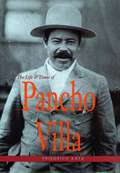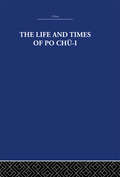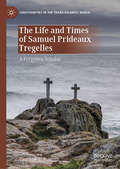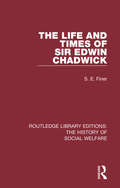- Table View
- List View
The Life Story Interview
by Robert G. AtkinsonFirst-person narratives are a fundamental tool of the qualitative researcher. This volume provides specific suggestions and guidelines for preparing and executing a life story interview. Robert Atkinson places the life story interview into a wider research context before elaborating on planning and then conducting the interview. Finally, the book deals with the issues of transcribing and interpreting the interview. The author provides a sample life story interview in the appendix.
The Life Within: Local Indigenous Society in Mexico's Toluca Valley, 1650-1800
by Caterina PizzigoniThe Life Withinprovides a social and cultural history of the indigenous people of a region of central Mexico in the later colonial period-as told through documents in Nahuatl and Spanish. It views the indigenous world from the inside out, focusing first on the household-buildings, lots, household saints-and expanding outward toward the householders and the greater community. The internal focus of this book provides a comprehensive picture of indigenous society, exploring the categories by which people are identified, their interactions, their activities, and the aspects of the local corporations that manifest themselves in household life. Pizzigoni brings indigenous-language social history into the later colonial period, whereas the emphasis until now has fallen heavily on the earlier phase. The late seventeenth and eighteenth centuries emerge as a dynamic time that saw, along with cultural persistence, many new adaptations and creations. Covering a period of over a century and a half, this study goes beyond a monolithic treatment of the region to introduce for the first time a systematic analysis of subregional variation in vocabulary and real-life phenomena, showing how, within larger regional trends, each tiniest community of the Toluca Valley retained markers of its individuality.
The Life Worth Living: Disability, Pain, and Morality
by Joel Michael ReynoldsA philosophical challenge to the ableist conflation of disability and pain More than 2,000 years ago, Aristotle said: &“let there be a law that no deformed child shall live.&” This idea is alive and well today. During the past century, Supreme Court Justice Oliver Wendell Holmes Jr. argued that the United States can forcibly sterilize intellectually disabled women and philosopher Peter Singer argued for the right of parents to euthanize certain cognitively disabled infants. The Life Worth Living explores how and why such arguments persist by investigating the exclusion of and discrimination against disabled people across the history of Western moral philosophy. Joel Michael Reynolds argues that this history demonstrates a fundamental mischaracterization of the meaning of disability, thanks to the conflation of lived experiences of disability with those of pain and suffering. Building on decades of activism and scholarship in the field, Reynolds shows how longstanding views of disability are misguided and unjust, and he lays out a vision of what an anti-ableist moral future requires. The Life Worth Living is the first sustained examination of disability through the lens of the history of moral philosophy and phenomenology, and it demonstrates how lived experiences of disability demand a far richer account of human flourishing, embodiment, community, and politics in philosophical inquiry and beyond. Accessibility features: Retail e-book files for this title are screen-reader friendly with images accompanied by short alt text and/or extended descriptions.
The Life You Can Save: Acting Now to End World Poverty
by Peter SingerThis is the right time to ask yourself: "What should I be doing to help?" For the first time in history, it is now within our reach to eradicate world poverty and the suffering it brings. Yet around the world, a billion people struggle to live each day on less than many of us pay for bottled water. And though the number of deaths attributable to poverty worldwide has fallen dramatically in the past half-century, nearly ten million children still die unnecessarily each year. The people of the developed world face a profound choice: If we are not to turn our backs on a fifth of the world's population, we must become part of the solution. In The Life You Can Save, philosopher Peter Singer, named one of "The 100 Most Influential People in the World" by Time magazine, uses ethical arguments, provocative thought experiments, illuminating examples, and case studies of charitable giving to show that our current response to world poverty is not only insufficient but ethically indefensible. Singer contends that we need to change our views of what is involved in living an ethical life. To help us play our part in bringing about that change, he offers a seven-point plan that mixes personal philanthropy (figuring how much to give and how best to give it), local activism (spreading the word in your community), and political awareness (contacting your representatives to ensure that your nation's foreign aid is really directed to the world's poorest people). In The Life You Can Save, Singer makes the irrefutable argument that giving will make a huge difference in the lives of others, without diminishing the quality of our own. This book is an urgent call to action and a hopeful primer on the power of compassion, when mixed with rigorous investigation and careful reasoning, to lift others out of despair.
The Life and Adventures of James P. Beckwourth: Mountaineer, Scout, and Pioneer, and Chief of the Crow Nation of Indians. With Illustrations
by James P. Beckwourth"The Life and Adventures of James P. Beckwourth: Mountaineer, Scout, and Pioneer, and Chief of the Crow Nation of Indians. With Illustrations" is an exhilarating autobiographical account of one of the most colorful and dynamic figures of the American frontier. James P. Beckwourth, an African American born into slavery, rose to become a legendary trapper, trader, explorer, and chief of the Crow Nation. This remarkable narrative, richly illustrated, brings to life the extraordinary exploits and adventures of a true American pioneer.Beckwourth's memoir, dictated to Thomas D. Bonner, spans the vast, untamed landscapes of the 19th-century American West. From his early days as a fur trapper in the Rocky Mountains to his time as a scout for the U.S. Army, Beckwourth's life was one of constant adventure and peril. His vivid storytelling captures encounters with Native American tribes, dangerous wildlife, and treacherous terrain, painting a vivid picture of the challenges and triumphs faced by those who ventured into the frontier.One of the most fascinating aspects of Beckwourth's life is his deep integration into the Crow Nation, where he was accepted as a chief and respected warrior. His unique perspective offers invaluable insights into the culture, customs, and conflicts of the Crow people during a pivotal time in their history. Beckwourth's narrative is not only a personal saga of survival and resilience but also a significant historical document that sheds light on the diverse interactions between Native Americans and settlers."The Life and Adventures of James P. Beckwourth" is a compelling and essential read for historians, adventure enthusiasts, and anyone interested in the untold stories of the American frontier. With its captivating prose and detailed illustrations, this autobiography stands as a testament to the indomitable spirit and extraordinary life of James P. Beckwourth, a man who truly lived on the edge of history.
The Life and Afterlife of Gay Neighborhoods: Renaissance and Resurgence (The Urban Book Series)
by Daniel Baldwin Hess Alex BittermanThis open access book examines the significance of gay neighborhoods (or ‘gayborhoods’) from critical periods of formation during the gay liberation and freedom movements of the 1960s and 1970s, to proven durability through the HIV/AIDS pandemic during the 1980s and 1990s, to a mature plateau since 2000. The book provides a framework for contemplating the future form and function of gay neighborhoods. Social and cultural shifts within gay neighborhoods are used as a framework for understanding the decades-long struggle for LGBTQ+ rights and equality.Resulting from gentrification, weakening social stigma, and enhanced rights for LGBTQ+ people, gay neighborhoods have recently become “less gay,” following a 50-year period of resilience. Meanwhile, other neighborhoods are becoming “more gay,” due to changing preferences of LGBTQ+ individuals and a propensity for LGBTQ+ families to form community in areas away from established gayborhoods. The current ‘plateau’ in the evolution of gay neighborhoods is characterized by generational differences—between Baby Boom pioneers and Millennials who favour broad inclusivity—signaling various possible trajectories for the future ‘afterlife’ of these important LGBTQ+ urban spaces.The complicating impacts of the COVID-19 pandemic provides a point of comparison for lessons learned from gay neighborhoods and the LGBTQ+ community that bravely endured the onset of the HIV/AIDS pandemic.This book will be of interest to students and scholars in various disciplines—including sociology, social work, anthropology, gender and sexuality, LGTBQ+ and queer studies, as well as urban geography, architecture, and city planning—and to policymakers and advocates concerned with LGBTQ+ rights and social justice.
The Life and Afterlife of Harry Houdini
by Joe PosnanskiJoe Posnanski enters the colorful world of Harry Houdini and his legions of devoted fans to explore the illusionist&’s impact on global culture—and why his legacy endures to this day. Nearly a century after Harry Houdini died on Halloween in 1926, he feels as modern and alive as ever. The name Houdini still leaps to mind whenever we witness a daring escape. The baby who frees herself from her crib? Houdini. The dog who vanishes and reappears in the neighbor&’s garden? Houdini. Every generation produces new disciples of the magician, from household names in magic like David Copperfield and David Blaine to countless other followers whose lives have been transformed by the power of Houdini. In rural Pennsylvania, a thirteen-year-old girl finds the courage to leave a violent home after learning that Houdini ran away to join the circus; she eventually becomes the first female magician to saw a man in half on television. In Australia, an eight-year-old boy with a learning impediment feels worthless until he sees an old poster of Houdini advertising &“Nothing on earth can hold Houdini prisoner,&” and begins his path to becoming that nation&’s most popular magician. In California, an actor and Vietnam War veteran finds purpose in his life by uncovering the secrets of his hero. But the unique phenomenon of Houdini was always more than his death-defying stunts or his ability to escape handcuffs and straitjackets. It is also about the power of imagination and self-invention. His incredible transformation from Ehrich Weiss, humble Hungarian immigrant and rabbi&’s son, into the self-named Harry Houdini has won him a slice of immortality. No one has withstood the test of time quite like Houdini. Fueled by Posnanski&’s personal obsession with the magician—and magic itself—The Life and Afterlife of Harry Houdini is a poignant odyssey of discovery, blending biography, memoir, and first-person reporting to trace Houdini&’s metamorphosis into an iconic figure who has inspired millions.
The Life and Afterlife of Isabeau of Bavaria (Rethinking Theory)
by Tracy AdamsThe fascinating history of Isabeau of Bavaria is a tale of two queens. During her lifetime, Isabeau, the long-suffering wife of mad King Charles VI of France, was respected and revered. After her death, she was reviled as an incompetent regent, depraved adulteress, and betrayer of the throne. Asserting that there is no historical support for this posthumous reputation, Tracy Adams returns Isabeau to her rightful place in history. Adulteress and traitor—two charges long leveled against the queen—are the first subjects of Adam’s reinterpretation of medieval French history. Scholars have concluded that the myths of Isabeau’s scandalous past are just that: rumors that evolved after her death in the context of a political power struggle. Unfortunately, this has not prevented the lies from finding their way into respected studies on the period. Adams’s own work serves as a corrective, rehabilitating the reputation of the good queen and exploring the larger topic of memory and the creation of myth. Adams next challenges the general perception that the queen lacked political acumen. With her husband incapacitated by insanity, Isabeau was forced to rule a country ripped apart by feuding, power-hungry factions. Adams argues that Isabeau handled her role astutely in such a contentious environment, preserving the monarchy from the incursions of the king’s powerful male relatives. Taking issue with history’s harsh treatment of a woman who ruled under difficult circumstances, Adams convincingly recasts Isabeau as a respected and competent queen.
The Life and Comics of Howard Cruse: Taking Risks in the Service of Truth (Critical Graphics)
by Andrew J. KunkaThe Life and Comics of Howard Cruse tells the remarkable story of how a self-described “preacher’s kid” from Birmingham, Alabama, became the so-called “Godfather of Gay Comics.” This study showcases a remarkable fifty-year career that included working in the 1970s underground comics scene, becoming founding editor of the groundbreaking anthology series Gay Comix, and publishing the graphic novel Stuck Rubber Baby, partially based on his own experience of coming of age in the Civil Rights era. Through his exploration of Cruse’s life and work, Andrew J. Kunka also chronicles the dramatic ways that gay culture changed over the course of Cruse’s lifetime, from Cold War-era homophobia to the gay liberation movement to the AIDS crisis to the legalization of gay marriage. Highlighting Cruse’s skills as a trenchant satirist and social commentator, Kunka explores how he cast a queer look at American politics, mainstream comics culture, and the gay community’s own norms. Lavishly illustrated with a broad selection of comics from Cruse’s career, this study serves as a perfect introduction to this pioneering cartoonist, as well as an insightful read for fans who already love how his work sketched a new vision of gay life.
The Life and Crimes of Railroad Bill: Legendary African American Desperado
by Larry L. MasseyFor over a year, Railroad Bill eluded sheriffs, private detectives hired by the L&N line, and bounty hunters who traveled across the country to match guns with the legendary desperado. The African American outlaw was wanted on multiple charges of robbery and murder, and rumor had it that he stole from the rich to give to the poor. He terrorized busy train lines from east of Mobile to the Florida Panhandle, but as soon as the lawmen got close, he disappeared into the bayous and pine forests--until one day his luck ran out, and he was gunned down inside a general store in Atmore, Alabama.Little is known about Railroad Bill before his infamy--not his real name or his origins. His first recorded crime, carrying a repeating rifle without a license, led him into a gunfight with a deputy and made him a wanted man throughout Florida in 1894. His most celebrated escape--a five-day foot chase with scores of men and several bloodhounds--led to tales of Railroad's supernatural ability to transmogrify into an animal or inanimate object at will. As his crimes progressed from robbing boxcars to wounding trainmen to murdering sheriffs, more and more reward money was offered for his capture--dead or alive.Today, Railroad Bill is the subject of many folk songs popularized by singers such as Paul McCartney, Taj Mahal, Gillian Welch, and Ramblin' Jack Elliot. But who was he? Where did he come from? What events led to his murderous spree? And why did some view him as a hero?In Railroad Bill, Larry Massey separates fact from myth and teases out elusive truths from tall tales to ultimately reveal the man behind the bandit's mask.
The Life and Death of Mary Wollstonecraft
by Claire TomalinThe Life and Death of Mary Wollstonecraft is the acclaimed bestselling biography by Claire TomalinWinner of the Whitbread First Book PrizeWitty, courageous and unconventional, Mary Wollstonecraft was one of the most controversial figures of her day. She published A Vindication of the Rights of Women; travelled to revolutionary France and lived through the Terror and the destruction of the incipient French feminist movement; produced an illegitimate daughter; and married William Godwin before dying in childbed at the age of thirty-eight. Often embattled and bitterly disappointed, she never gave up her radical ideas or her belief that courage and honesty would triumph over convention.'Tomalin is a most intelligent and sympathetic biographer, aware of her impetuous subject's many failings, yet with the perception to present her greatness fairly. She writes well and wittily' Daily Telegraph'A vivid evocation not only of what Mary went through but also of how women lived in the second part of the eighteenth century. Most of all, however, Tomalin makes Mary Wollstonecraft unforgettable' Evening StandardFrom the acclaimed author of Samuel Pepys: The Unequalled Self, Charles Dickens: A Life and The Invisible Woman, this celebrated biography is the definitive account of Mary Wollstonecraft's life.Claire Tomalin is the award-winning author of eight highly acclaimed biographies, including: The Life and Death of Mary Wollstonecraft; Shelley and His World; Katherine Mansfield: A Secret Life; The Invisible Woman: The Story of Nelly Ternan and Charles Dickens; Mrs Jordan's Profession; Jane Austen: A Life; Samuel Pepys: The Unequalled Self; Thomas Hardy: The Time-Torn Man and, most recently, Charles Dickens: A Life. A former literary editor of the New Statesman and the Sunday Times, she is married to the playwright and novelist Michael Frayn.
The Life and Martyrdom of Diego Luis de San Vitores, S.J. (2nd Edition)
by Francisco García, S.J.The Life and Martyrdom of Diego Luis de San Vitores, S.J.is a collection of official and unofficial letters and documents in addition to testimonies collected shortly after the death of Diego Luis de San Vitores, S.J., the Jesuit priest who established the Catholic religion in the island of Guam in the late 1600s. This book captures both the life and events surrounding the death of San Vitores and a narrative of subsequent events in the Mariana Islands from 1672 to 1681. The scope of the book includes not just the four brief years of San Vitores’ time in Guam, but another ten years of missionary work following his death. It offers a detailed description of the early critical years of mission activity between 1668 and 1682 in this earliest of mission fields in Oceania.
The Life and Music of Booker "Bukka" White: Recalling the Blues (American Made Music Series)
by David W. JohnsonBooker “Bukka” White (1905–1977) was one of the most important blues musicians of the twentieth century. The twelve songs he recorded in Chicago in 1940 are considered to be among the finest in country blues. In The Life and Music of Booker “Bukka” White: Recalling the Blues, David W. Johnson traces the trajectory of White’s life from his early years in Chickasaw and Grenada Counties, Mississippi, through his imprisonment in the notorious Mississippi State Penal Farm in the late 1930s, to making a new life for himself in Memphis, Tennessee. For years only a name on old 78 records—and believed by some to be dead—White was “rediscovered” by John Fahey and ED Denson in the summer of 1963. He went on to have a productive second career, playing venues and festivals throughout the United States and in Canada, and touring Europe and Great Britain with the American Folk Blues Festival. In 1975, he was invited to Bremen, Germany, for a solo concert that was released as his final album. In July 1976, the author interviewed White shortly before his discharge from a Massachusetts hospital where he was recovering from a stroke. After spending eight days in the intensive care unit and three weeks in rehabilitation, White was ready to talk about his life. Recalling stories of “slavery time,” White told the author, “. . . some of the [formerly enslaved] guys were wise enough to hold that in their head where they could tell a young pants, where it would go down in history, you know. Just like you doing that now—something happen to you, somebody else will carry that on.” The product of years of research, The Life and Music of Booker “Bukka” White is the first full-length biography of this remarkable country blues performer. Interviewing those who knew White, including his second cousin B. B. King, Johnson has written a detailed and sometimes surprising account of how a young Black man born in the first decade of the twentieth century—the grandson of a slave—found a way to rise above his circumstances and maintain a decades-long career as a musician.
The Life and Music of Oliver Mtukudzi: Reconstruction and Identity
by Ezra Chitando Pauline Mateveke Munyaradzi Nyakudya Bridget ChinouririThis book is a critical reflection on the life and career of the late legendary Zimbabwean music icon, Oliver “Tuku” Mtukudzi, and his contribution towards the reconstruction of Zimbabwe, Africa and the globe at large. Mtukudzi was a musician, philosopher, and human rights activist who espoused the agenda of reconstruction in order to bring about a better world, proposing personal, cultural, political, religious and global reconstruction. With twenty original chapters, this vibrant volume examines various themes and dimensions of Mtukudzi’s distinguished life and career, notably, how his music has been a powerful vehicle for societal reconstruction and cultural rejuvenation, specifically speaking to issues of culture, human rights, governance, peacebuilding, religion and identity, humanism, gender and politics, among others. The contributors explore the art of performance in Mtukudzi’s music and acting career, and how this facilitated his reconstruction agenda, offering fresh and compelling perspectives into the role of performing artists and cultural workers such as Mtukudzi in presenting models for reconstructing the world.
The Life and Times Of Cleopatra: Queen of Egypt (Historical Figures Ser.)
by Arthur E. WeigallThis comprehensive treatment of Cleopatra and the political and social world in which she lived will be an indispensable resource for anyone interested in Cleopatra or in ancient Egypt. Laying bare the "injustice, the adverse partiality, of the attitude assumed by classical authors," the author offers the reader a new, more balanced look at the life of one of history's most important women. The book is divided into sections on Cleopatra and Caesar and Cleopatra and Antony and is supplemented by a number of maps and illustrations.
The Life and Times of Chinua Achebe (Global Africa)
by Kalu OgbaaThe Life and Times of Chinua Achebe introduces readers to the life, literary works, and times of arguably the most widely-read African novelist of recent times, an icon, both in continental Africa and abroad. The book weaves together the story of Chinua Achebe, a young Igboman whose novel Things Fall Apart opened the eyes of the world to a more realistic image of Africa that was warped by generations of European travelers, colonists, and writers. Whilst continuing to write further influential novels and essays, Achebe also taught other African writers to use their skills to help their national leaders to fight for their freedoms in the post-colonial era, as internal warfare compounded the damage caused by European powers during the colonial era. In this book Kalu Ogbaa, an esteemed expert on Achebe and his works, draws on extensive research and personal interviews with the great man and his colleagues and friends, to tell the story of Achebe and his work. This intimate and powerful new biography will be essential reading for students and scholars of Chinua Achebe, and to anyone with an interest in the literature and post-colonial politics of Africa.
The Life and Times of Elijah Muhammad
by Claude Andrew CleggElijah Muhammad (1897-1975) was one of the most significant and controversial black leaders of the twentieth century. His followers called him the Messenger of Allah, while his critics labeled him a teacher of hate. Southern by birth, Muhammad moved north, eventually serving as the influential head of the Nation of Islam for over forty years. Claude Clegg III not only chronicles Muhammad's life, but also examines the history of American black nationalists and the relationship between Islam and the African American experience.In this authoritative biography, which also covers half a century of the evolution of the Nation of Islam, Clegg charts Muhammad's early life, his brush with Jim Crow in the South, his rise to leadership of the Nation of Islam, and his tumultuous relationship with Malcolm X. Clegg is the first biographer to weave together speeches and published works by Muhammad, as well as delving into declassified government documents, insider accounts, audio and video records, and interviews, producing the definitive account of an extraordinary man and his legacy.
The Life and Times of Frederick Douglass: His Early Life as a Slave, His Escape from Bondage, and His Complete History
by Frederick DouglassBorn in slavery on a Maryland plantation around 1817, Frederick Douglass spent the first twenty years of his life in bondage. Taught to read and write by one of his owners, he went on to become a brilliant writer, eloquent orator, and a major participant in the struggle of African-Americans for freedom and equality. In this remarkable firsthand narrative, originally published in 1845, Douglass vividly recounts his early years filled with physical abuse, deprivation, and tragedy; dramatic escapes to the North, recapture, and eventual freedom; work for the Anti-Slavery Society and influential role in speaking for other former slaves; abolitionist campaigns and crusade for civil rights. A powerful autobiography of a passionate integrationist, The Life and Times of Frederick Douglass will be an important addition to the library of anyone interested in African-American history.
The Life and Times of Frederick Douglass: Written By Himself (African American)
by Frederick DouglassRaised as a plantation slave, Douglass went on to become a writer, orator, and major participant in the struggle for African-American freedom and equality. In this engrossing narrative he recounts early years of abuse; his dramatic escape to the North and eventual freedom, abolitionist campaigns, and his crusade for full civil rights for former slaves.
The Life and Times of Hannah Crafts: The True Story of The Bondwoman's Narrative
by Gregg HecimovichA finalist for the National Book Critics Circle Award for Biography and the Los Angeles Times Book PrizeA groundbreaking study of the first Black female novelist and her life as an enslaved woman, from the biographer who solved the mystery of her identity, with a forward by Henry Louis Gates Jr.In 1857, a woman escaped enslavement on a North Carolina plantation and fled to a farm in New York. In hiding, she worked on a manuscript that would make her famous long after her death. The novel, The Bondwoman’s Narrative, was first published in 2002 to great acclaim, but the author’s identity remained unknown. Over a decade later, Professor Gregg Hecimovich unraveled the mystery of the author’s name and, in The Life and Times of Hannah Crafts, he finally tells her story.In this remarkable biography, Hecimovich identifies the novelist as Hannah Bond “Crafts.” She was not only the first known Black woman to compose a novel but also an extraordinarily gifted artist who honed her literary skills in direct opposition to a system designed to deny her every measure of humanity. After escaping to New York, the author forged a new identity—as Hannah Crafts—to make sense of a life fractured by slavery.Hecimovich establishes the case for authorship of The Bondwoman’s Narrative by examining the lives of Hannah Crafts’s friends and contemporaries, including the five enslaved women whose experiences form part of her narrative. By drawing on the lives of those she knew in slavery, Crafts summoned into her fiction people otherwise stolen from history.At once a detective story, a literary chase, and a cultural history, The Life and Times of Hannah Crafts discovers a tale of love, friendship, betrayal, and violence set against the backdrop of America’s slide into Civil War.
The Life and Times of Louis Lomax: The Art of Deliberate Disunity
by Thomas AielloSyndicated television and radio host. Serial liar. Pioneering journalist. Convicted criminal. Close ally of Malcolm X and Martin Luther King Jr. Publicity-seeking provocateur. Louis Lomax's life was a study in contradiction. In this biography, Thomas Aiello traces the complicated and fascinating arc of Lomax's life and career, showing how the contradictions, tumult, and inconsistencies that marked his life reflected those of 1960s America. Aiello takes readers from Lomax's childhood in the Deep South to his early confidence schemes to his emergence as one of the loudest and most influential voices of the civil rights movement. Regardless of what political position he happened to take at any given moment, Lomax preached “the art of deliberate disunity,” in which the path to democracy could only be achieved through a diversity of opinions. Engaging and broad in scope, The Life and Times of Louis Lomax is the definitive study of one of the civil rights era's most complicated, important, and overlooked figures.
The Life and Times of Pancho Villa
by Friedrich KatzAlongside Moctezuma and Benito Ju#65533;rez, Pancho Villa is probably the best-known figure in Mexican history. Villa legends pervade not only Mexico but the United States and beyond, existing not only in the popular mind and tradition but in ballads and movies. There are legends of Villa the Robin Hood, Villa the womanizer, and Villa as the only foreigner who has attacked the mainland of the United States since the War of 1812 and gotten away with it. Whether exaggerated or true to life, these legends have resulted in Pancho Villa the leader obscuring his revolutionary movement, and the myth in turn obscuring the leader. Based on decades of research in the archives of seven countries, this definitive study of Villa aims to separate myth from history. So much attention has focused on Villa himself that the characteristics of his movement, which is unique in Latin American history and in some ways unique among twentieth-century revolutions, have been forgotten or neglected. Villa's Divisi#65533;n del Norte was probably the largest revolutionary army that Latin America ever produced. Moreover, this was one of the few revolutionary movements with which a U. S. administration attempted, not only to come to terms, but even to forge an alliance. In contrast to Lenin, Mao Zedong, Ho Chi Minh, and Fidel Castro, Villa came from the lower classes of society, had little education, and organized no political party. The first part of the book deals with Villa's early life as an outlaw and his emergence as a secondary leader of the Mexican Revolution, and also discusses the special conditions that transformed the state of Chihuahua into a leading center of revolution. In the second part, beginning in 1913, Villa emerges as a national leader. The author analyzes the nature of his revolutionary movement and the impact of Villismo as an ideology and as a social movement. The third part of the book deals with the years 1915 to 1920: Villa's guerrilla warfare, his attack on Columbus, New Mexico, and his subsequent decline. The last part describes Villa's surrender, his brief life as a hacendado, his assassination and its aftermath, and the evolution of the Villa legend. The book concludes with an assessment of Villa's personality and the character and impact of his movement.
The Life and Times of Po Chü-i
by Arthur Waley The Arthur EstateFirst published in 1949. This book gives the biographical background to the many poems of Po Chü-I (A.D 772-846) and traces the connection between his literary career and the disturbed political life of the time. The volume also provides new translations in whole or in part of about a hundred poems by Po Chü-i.
The Life and Times of Samuel Prideaux Tregelles: A Forgotten Scholar (Christianities in the Trans-Atlantic World)
by Timothy C. StuntThis book sheds light on the career of Samuel Prideaux Tregelles, and in doing so touches on numerous aspects of nineteenth-century British and European religious history. Several recent scholars have celebrated the 200th anniversary of the German textual critic Tischendorf but Tregelles, his contemporary English rival, has been neglected, despite his achievements being comparable. In addition to his decisive contribution to Biblical textual scholarship, this study of Tregelles’ career sheds light on developments among Quakers in the period, and Tregelles’s enthusiastic involvement with the early nineteenth-century Welsh literary renaissance usefully supplements recent studies on Iolo Morganwg. The early career of Tregelles also gives valuable fresh detail to the origins of the Plymouth Brethren, (in both England and Italy) the study of whose early history has become more extensive over the last twenty years. The whole of Tregelles’s career therefore illuminates neglected aspects of Victorian religious life.
The Life and Times of Sir Edwin Chadwick (Routledge Library Editions: The History of Social Welfare #2)
by S. E. FinerFirst published in 1952, this is a full-scale and definitive account of the life and work of Sir Edwin Chadwick. Among the sources used are the Chadwick Papers, the Peel, Place, Russell and Gladstone Papers, the Home Office, Treasury and Ministry of Health papers and the minutes and documents of the Metropolitan Commission of Sewers. Centred on this mass of material, this book demonstrates that the great social reforms of the Victorian age should be attributed, not so much to the Cabinets, but to the labours of a handful of civil servants. It also argues that Edwin Chadwick was the most influential of these civil servants and through this illuminating biography, Professor Finer gives an account of early Victorian administration as seen from inside. This book will be of interest to those studying Victorian social reform, the history of the welfare state and social policy.
